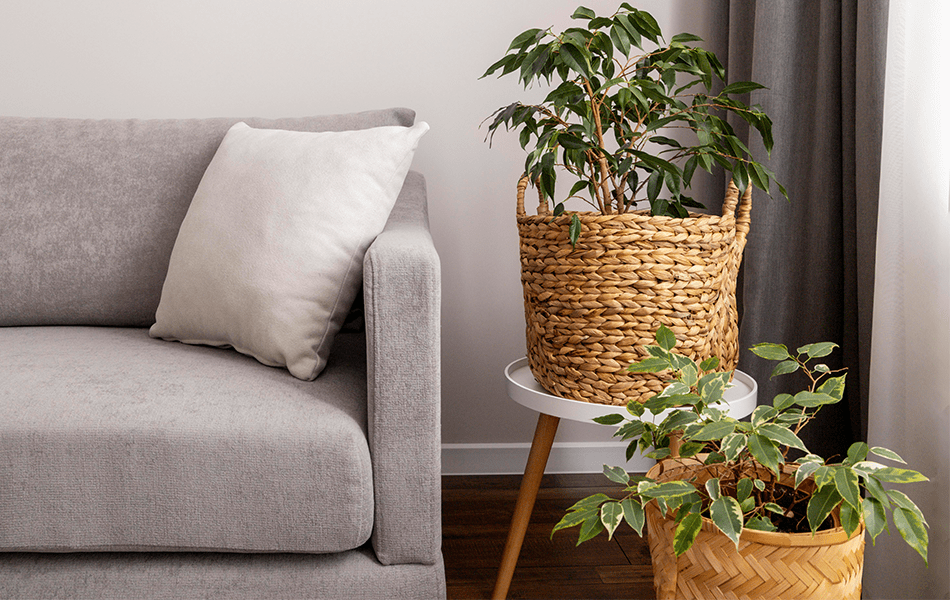It is no secret that spending time in nature can be incredibly beneficial for both our physical health and mental wellbeing. However, for many of us, the opportunity to spend time in nature is not always available. Fortunately, there are plenty of ways to bring nature into our living spaces, so that we can still enjoy its calming and rejuvenating effects.
Whether you have a small garden, balcony or even just an indoor pot plant, there are plenty of ways to introduce elements of nature into your space. Here are some tips to help you bring a little bit of nature into your home.
1. Introduce greenery
Adding plants to your home can be an ideal way to bring the natural world into your living space. Greenery can create a calming atmosphere and is a great way to add a splash of color to your home. Choose low maintenance plants that won’t require too much care and attention.
2. Create a natural decor theme
Using natural elements throughout your home décor can be a great way to bring the outdoors in. Try incorporating natural materials such as wood, stone, and fabrics in your interior design. This will create a more natural and calming ambience.
3. Invest in eco-friendly furniture
When choosing furniture for your home, look for pieces made from sustainable materials such as bamboo, rattan, and seagrass. Not only are these materials eco-friendly, but they also look beautiful and can bring a natural feel to your home.
4. Add water elements
Introducing water elements to your home can help to add a peaceful and calming atmosphere. This can be done through the use of indoor water features such as fountains or ponds, or through the use of aquariums.
5. Utilize natural light
Making the most of natural light is a great way to bring the outdoors into your home. Utilize windows and skylights to bring in as much natural light as possible. This will help to make your home feel brighter and more energized.
5 Steps in caring for indoor plans
Caring for indoor plants is an important aspect of keeping them healthy and thriving. Here are some tips to help you care for your indoor plants:
1. Watering
Most indoor plants prefer to be kept evenly moist, but not waterlogged. Check the soil regularly and water when the top inch of soil is dry. Be sure to use room temperature water and allow excess water to drain away.
2. Light
Different indoor plants have different light requirements. Some plants prefer bright, direct sunlight, while others prefer indirect or low light. Make sure you understand the light requirements of your plants and place them in the appropriate location.
3. Humidity
Indoor plants thrive in a humid environment. You can increase the humidity around your plants by misting them with water, grouping them together, or using a humidifier.
The NASA Clean Air Study showed houseplants and their associated microorganisms can remove volatile organic compounds from indoor air. Pollution is not only found in the outdoor air of dense cities, but also inside the places we work, visit, or call home. That’s because airborne toxins and pollutant gases can be emitted from mechanical equipment, building materials, and even everyday objects.
4. Fertilizer
Indoor plants benefit from regular fertilization. Use a balanced fertilizer every 4-6 weeks during the growing season (spring and summer) and reduce or stop fertilization during the dormant season (fall and winter).
5. Pruning
Regular pruning can help keep indoor plants healthy and promote new growth. Remove any dead or damaged leaves or stems and pinch back the tips of the plant to encourage branching.
It is beneficial to keep plants indoors because they provide a number of advantages. They can relieve stress and anxiety, raise mood and productivity, and add beauty and aesthetic appeal to your indoor area. They can also improve air quality by eliminating toxins and raising oxygen levels.
As an added bonus, caring for indoor plants can be a fulfilling and therapeutic hobby. To preserve their health and lifespan, you should take care to select the ideal plants for your interior setting and to maintain them properly.
By following these tips, you can help ensure that your indoor plants stay healthy and beautiful for years to come.
Best type of plants for indoors
Low maintenance plants are ideal for those of us with busy lifestyles, who don’t have the time or energy to devote to more intensive gardening. Many plants can be grown indoors with a minimum of effort, allowing you to bring a bit of nature into your home without the hassle of taking care of a large outdoor garden.
Some of the most popular low maintenance plants include the snake plant, pothos, aloe vera, Chinese evergreen, and peace lily. These plants require very little water and fertilizer, and can thrive in areas with only minimal light. Not only do these plants look beautiful, but they can also act as natural air purifiers, removing harmful toxins from the air. There are several houseplants that produce high levels of oxygen.
Here are some of the top oxygen-producing potted plants:
1. Pothos (Epipremnum aureum)
Pothos is the number one houseplant for oxygen due to its fast conversion rate. It also helps to reduce carbon dioxide levels in a room.
2. Snake plant (Sansevieria trifasciata)
The snake plant is known for its air-purifying qualities and ability to release oxygen at night. It is also effective at filtering out toxins such as formaldehyde, benzene, and xylene. Study found that the soil in potted plants can also help clean indoor air.
3. Areca palm (Dypsis lutescens)
The Areca palm is a great plant of indoor for oxygen, as it can produce a significant amount of oxygen while also removing harmful toxins from the air.
4. Boston fern (Nephrolepis exaltata)
Boston ferns are great at removing pollutants such as formaldehyde and xylene, and they are also one of the best plants for producing oxygen.
5. Spider plant (Chlorophytum comosum)
Spider plants are great for producing oxygen and filtering out toxins such as carbon monoxide, formaldehyde, and benzene. They are also very easy to care for.
Houseplants absorb carbon dioxide and filter pollutants. “This is an important idea considering how much time people spend indoors,” Rothenberg adds. “By adding more oxygen, theoretically, you might have better focus, fewer headaches, and an improved mood.” Snake plants, spider plants , rubber plants , peace lilies , ferns , and English ivy are some of the best houseplants for boosting oxygen levels and purifying the air.
By increasing indoor humidity levels with houseplants, you can help improve respiratory health and combat issues like dry, frizzy hair and parched winter skin. Some of the best plants for increasing indoor humidity are the common spider plant. A recent study found that adding a few spider plants to a home increases indoor humidity levels from 20% to 30% in a short period of time.
Air Purifying plants
Air purifying plants are an excellent way to keep your indoor air clean, healthy, and free from pollutants. Not only do these plants reduce air pollution, they also help to reduce dust, filter out harmful toxins, and provide a natural, pleasant scent to your home.
Popular air purifying houseplants include Spider plants, Snake plants, Peace Lilies, Philodendrons, and Dracaenas – all of which have the ability to absorb pollutants from the air and enhance the quality of your living or working space.
So, if you’re looking to make your indoor air healthier and cleaner, add one or more of these air purifying plants to your home or office today!
Succulents
If you’re looking for a low-maintenance houseplant that will brighten up your home, then succulent potted plants are the perfect choice. Succulents are easy to care for, require minimal watering and make a great addition to any room. Whether you’re looking for a small plant to set on your windowsill or something larger to decorate your living room, succulents are a great way to add some life to your home without the hassle of a traditional houseplant.
There are many different varieties of succulents that make great house plants. Popular varieties include the jade plant, aloe vera, string of pearls, and succulent garden. Each of these plants offers unique foliage and color, making them a great addition to any space. They are also easy to care for and require minimal watering, making them a great choice for busy households.
When choosing succulent plants, the main thing to consider is where will you be placing them in your home. If you’re planning on placing them in a sunny spot, then make sure to choose a variety that can handle direct sunlight. Some succulents are actually sun-tolerant, but be sure to research each plant to make sure it can handle the amount of sunlight you plan to give it. If you plan on placing your succulents in a low light environment, then there are plenty of varieties that will thrive in those conditions.
When caring for succulent plants, you’ll want to make sure to water them sparingly. Succulents don’t need a lot of water and can generally survive on a few cups of water every few weeks. Be sure to check the soil of your succulents every few days to make sure it is not becoming too dry or too wet. If it feels dry, then it’s time to give your succulents a drink.
Succulent plants are a great way to add some green to your home without the hassle of a traditional houseplant. With their unique foliage and easy-care requirements, succulents are a great choice for any indoor space.
If you’re looking for a low-maintenance houseplant with minimal care requirements, then succulents are the perfect choice for you!
Indoor Plants for Low Light Spaces
One of the first considerations when choosing a houseplant is the amount of light you can provide it. Yet, even if your property doesn’t have many big windows, you may still choose from our list of top indoor plants for low light. Use these easy-care houseplants to liven up that gloomy place in your living room or office because they can survive even in low light conditions
- Palms
- Pothos
- Dieffenbachia
- Gloxinia
- Boston Fern
- Philodendron
- ZZ Plant pots
- Adanson’s Monstera





